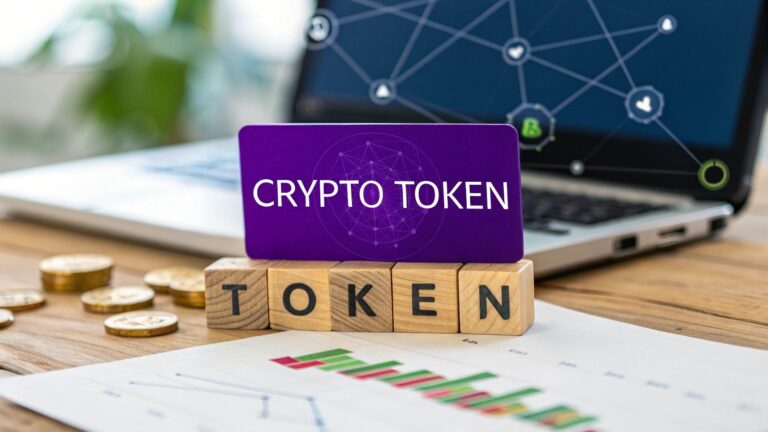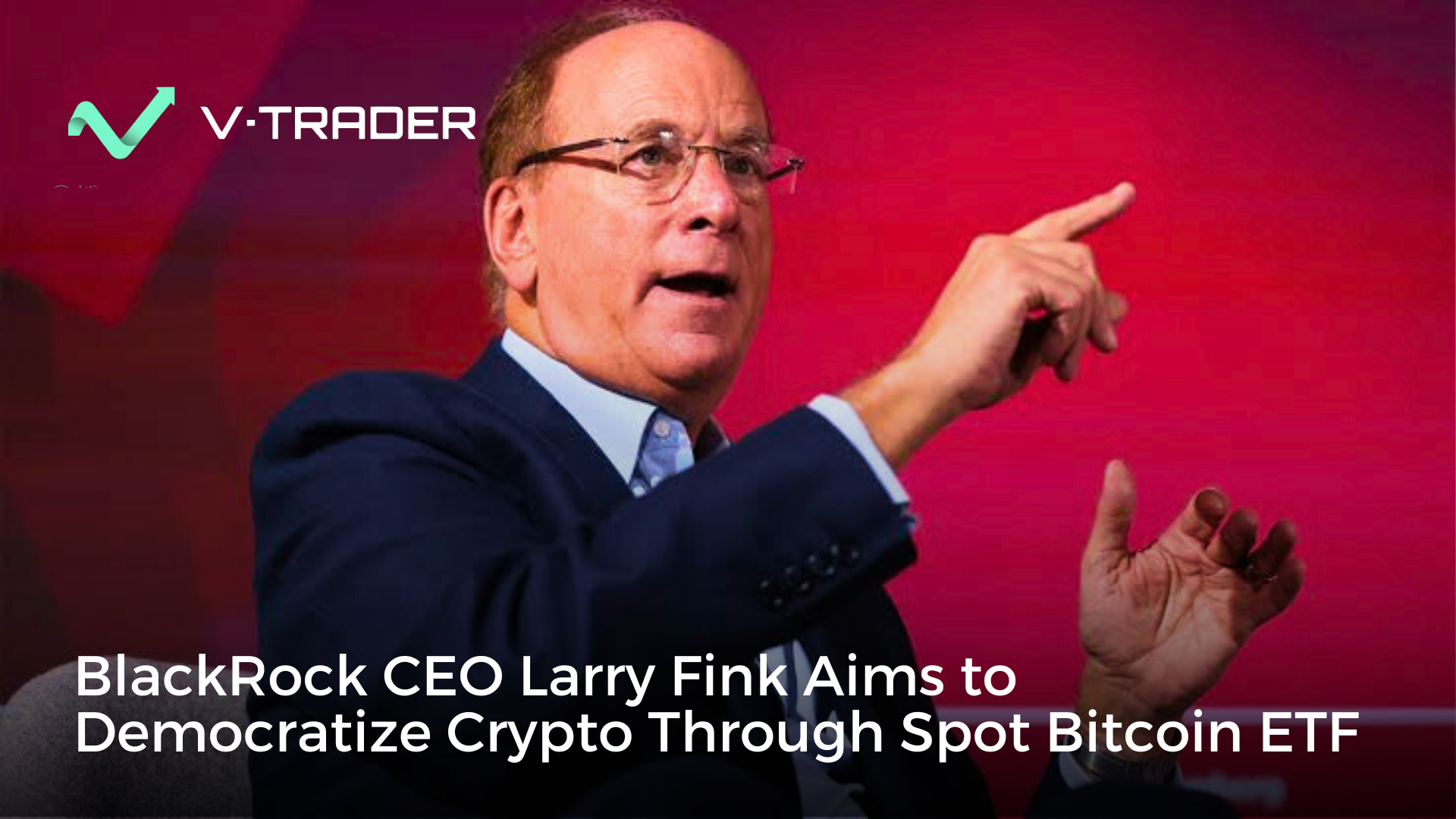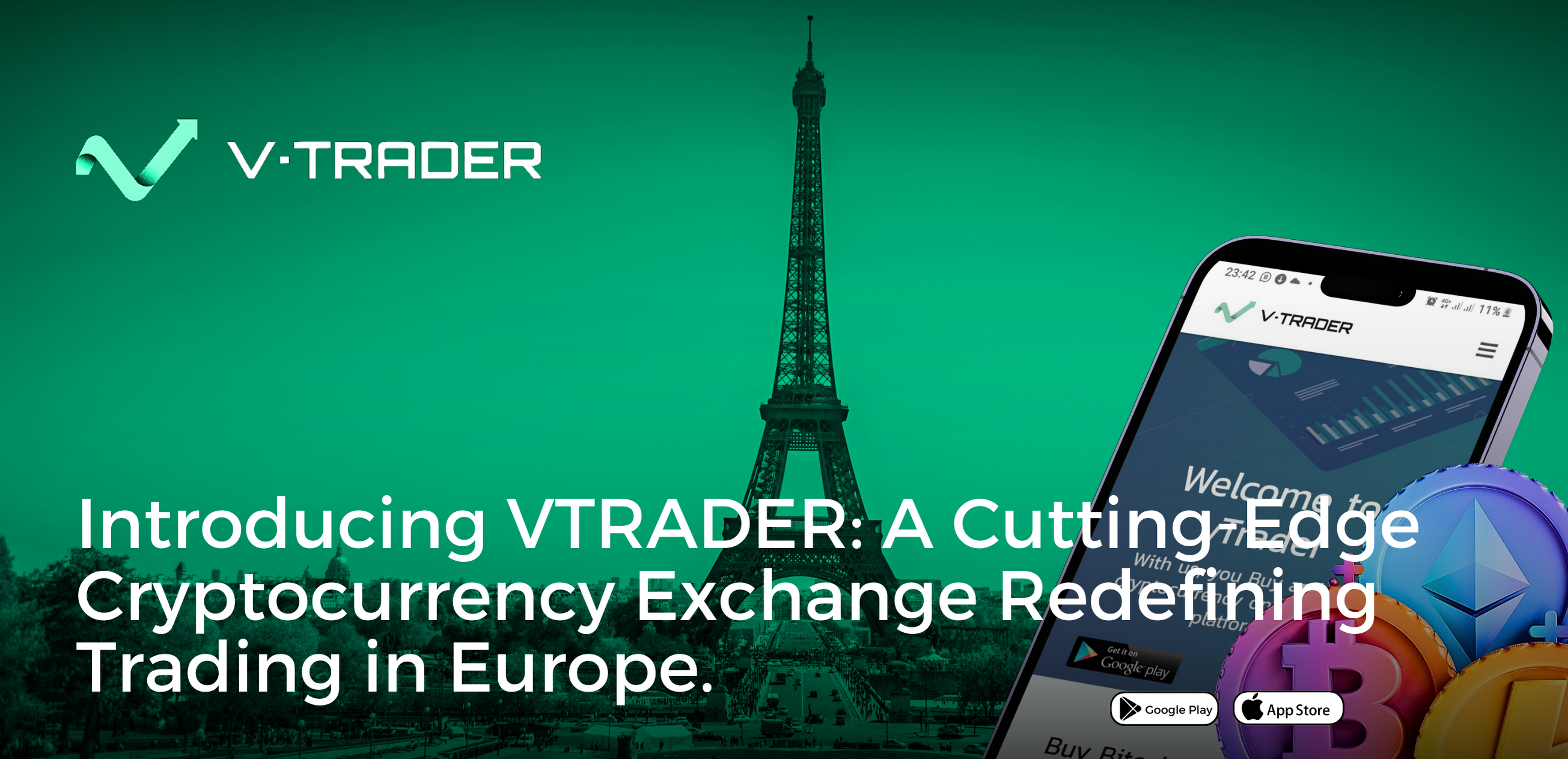In the crypto world, you'll hear "coin" and "token" thrown around a lot, sometimes interchangeably. But they're not the same thing. A token is a special kind of digital asset that represents a specific use or asset but operates on another cryptocurrency's blockchain.
Think of it like this: imagine the Ethereum blockchain is a massive, sprawling digital amusement park. The park's own money, a coin like ETH, is what you use to pay for your main entry ticket. A token, on the other hand, is like a special ticket for a single ride or a book of tickets for the arcade games inside.
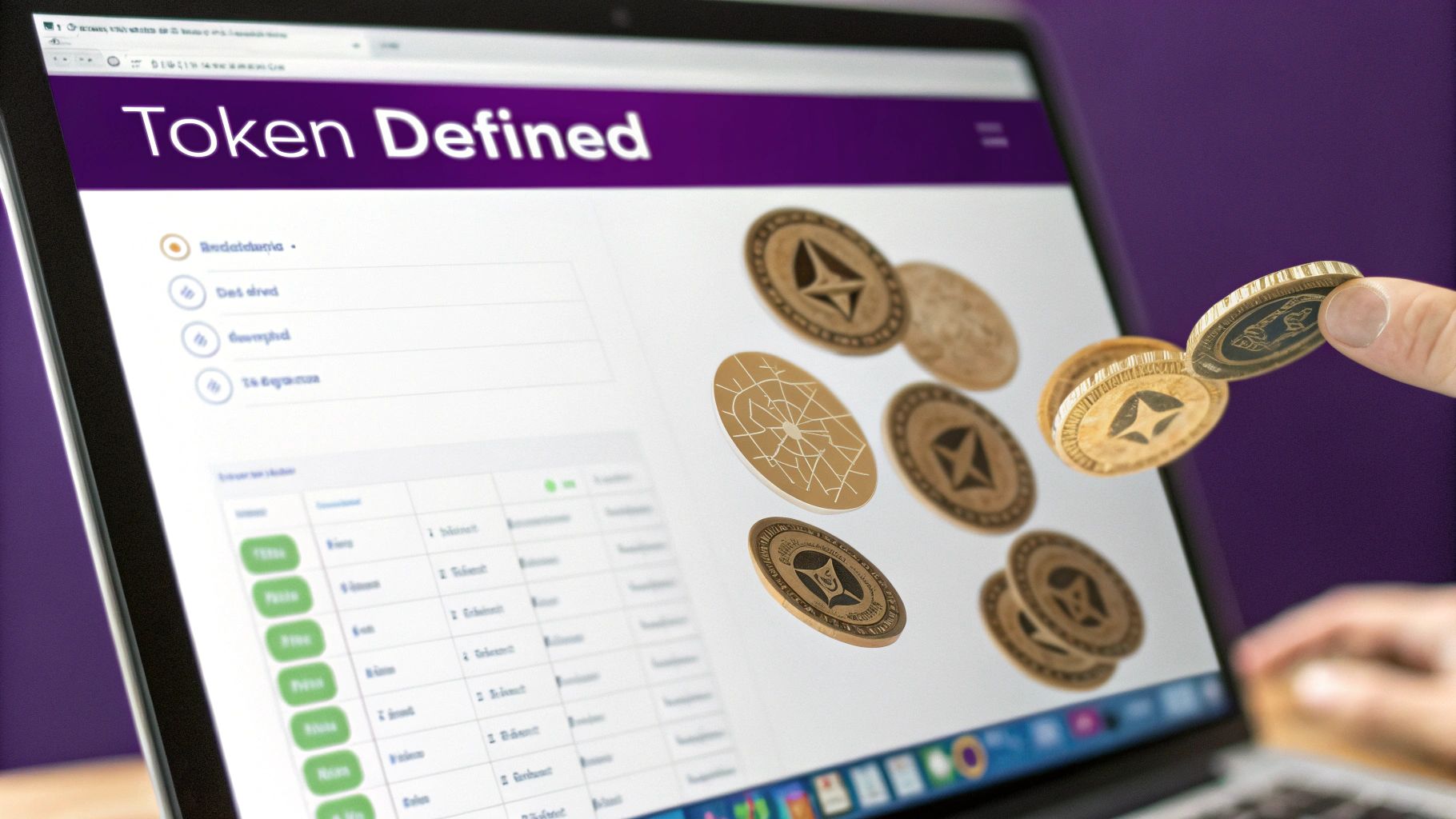
Understanding the Role of a Crypto Token
So, what really makes a token different? It's a versatile unit of value that doesn't have its own dedicated blockchain. Instead, tokens are built on top of existing, established networks like Ethereum, Solana, or Polygon.
This "piggybacking" is the key feature. Creating a brand-new coin means building an entire digital world from the ground up—a blockchain with its own rules, security protocols, and a community of people to keep it running. It's a monumental task.
Tokens cleverly bypass all that heavy lifting. They use the host blockchain's proven security and existing user base. They are brought to life using smart contracts, which are just bits of code that automatically execute the token's rules, like its total supply and what it can be used for.
The Amusement Park Analogy Expanded
Let's dive back into the amusement park analogy to really nail this down.
- The Blockchain (e.g., Ethereum): This is the entire theme park. It's the land, the infrastructure, the security guards (miners/validators), and the power grid keeping the lights on.
- The Cryptocurrency Coin (e.g., ETH): This is the park's official currency. You need it to pay the entrance fee and for essentials like food and drinks. The park simply can't function without it.
- The Cryptocurrency Token (e.g., UNI): This is a special-purpose ticket you buy inside the park. It might get you into a VIP lounge, let you play games in the arcade, or even give you a vote on which new ride should be built next.
That arcade ticket (the token) is only useful within the context of the amusement park (the blockchain). You can't use it to buy a hot dog, just as you can't use a specific app's token to pay the network fees on the blockchain itself. That's what the native coin is for.
Key Takeaway: Tokens are the building blocks for apps and projects that run on top of a blockchain. Coins are the native fuel that powers the blockchain itself. Grasping this difference is fundamental to making sense of the entire crypto ecosystem.
This setup has unleashed a massive wave of innovation. Developers can now focus on building incredible new applications and services without the enormous overhead of launching and securing a new blockchain every single time.
For anyone just getting started, platforms like vTrader offer a straightforward way to explore and trade this huge universe of both coins and tokens. Building a solid knowledge base is your best first step, and you can learn more about these core crypto concepts at the vTrader Academy. Soon, we'll get into just how these digital assets are reshaping everything from finance to gaming.
The Core Difference Between a Token and a Coin
While they often get lumped together, the difference between a token and a coin is fundamental, and it all comes down to their foundation. The best way to think about it is with a simple analogy.
Imagine a coin is like the native currency of its own independent country—a sovereign nation with its own government, laws, and infrastructure. A token, on the other hand, is more like a franchise business that opens up shop inside that country. It uses the nation's established roads, security, and economy to operate.
Put simply, a cryptocurrency coin (like Bitcoin or Ethereum) runs on its own dedicated blockchain. That blockchain is the public ledger recording every transaction, and the coin is absolutely essential for it to function. For instance, you can't use the Ethereum blockchain without paying transaction fees in its native coin, Ether (ETH).
A cryptocurrency token is different. It doesn't have its own blockchain. Instead, it’s built on top of an existing one using smart contracts. This distinction is one of the most important concepts to grasp if you want to understand how the crypto world really works.
The Host and The Guest
The relationship between a blockchain and the tokens it supports is a bit like a host and a guest. The host blockchain provides all the critical infrastructure:
- Security: Tokens are shielded by the security of their host blockchain. To attack a token, you’d have to attack the entire underlying blockchain—a massive and incredibly expensive undertaking.
- Consensus: Tokens piggyback on the host’s network of miners or validators to confirm transactions. They don't have to worry about creating their own system for reaching agreement.
- Infrastructure: They get to use the existing network, user base, and developer tools of the host chain, which dramatically lowers the barrier to entry for new projects.
This “guest” status makes creating a token a whole lot easier than launching a new coin from the ground up. Developers don't have to build an entire country from scratch; they just need to build their store within one that’s already up and running. This is what has fueled the explosion of creativity and new applications we see in crypto today.
A cryptocurrency token is a digital asset that resides on an existing blockchain, representing a value, utility, or asset, distinguished from cryptocurrencies like Bitcoin or Ethereum, which are native to their own blockchains. As of early this year, there are over 17,000 cryptocurrencies tracked globally, with thousands being tokens created mostly on the Ethereum blockchain and other smart-contract platforms. To explore the wider market, you can find more insights about the growth of cryptocurrencies.
Visualizing Token Diversity
To get a better feel for just how varied tokens can be, the image below shows a handful of different types you might come across while exploring the market.
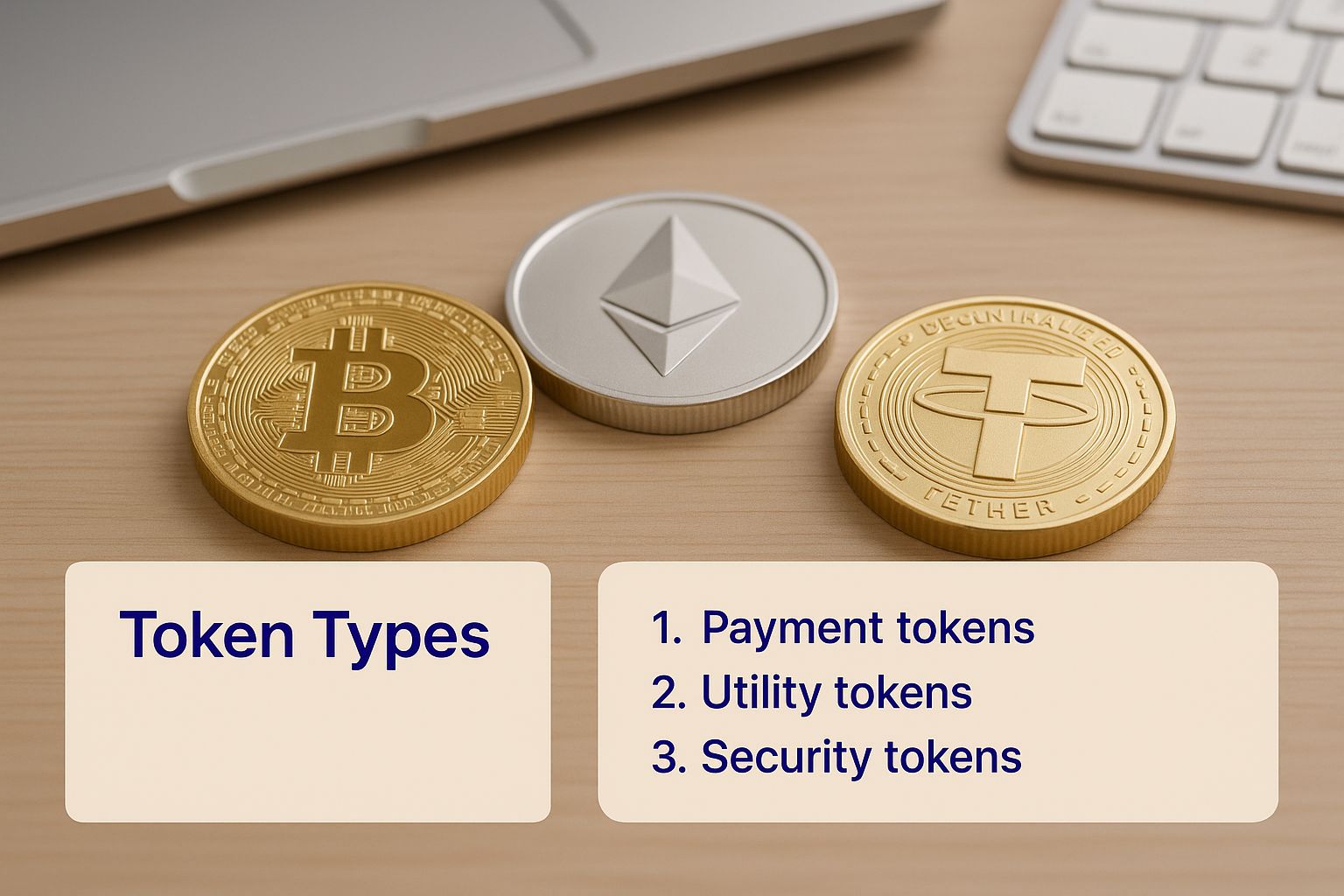
This really drives home the point that tokens aren't just one thing. They are a diverse collection of digital assets, each with its own unique design and purpose.
Token vs. Coin: A Head-to-Head Comparison
To make the distinction completely clear, let's break down their key attributes side-by-side. Getting these differences straight is crucial when you're sizing up a project or deciding what to trade on a platform like vTrader. The costs can also vary, and you can get the full details on vTrader's fee structure for both types of assets.
| Attribute | Cryptocurrency Coin | Cryptocurrency Token |
|---|---|---|
| Underlying Technology | Operates on its own independent and native blockchain. | Built on top of an existing blockchain (e.g., Ethereum, Solana). |
| Primary Function | Acts as a medium of exchange and a store of value; used to pay network fees. | Represents a specific utility, asset, or right within a project or app. |
| Creation Process | Requires building a new blockchain from the ground up, a complex process. | Created relatively easily using smart contracts on an existing platform. |
| Examples | Bitcoin (BTC), Ethereum (ETH), Litecoin (LTC) | Chainlink (LINK), Uniswap (UNI), Tether (USDT) – all on Ethereum |
At the end of the day, a coin is the fuel that powers a blockchain network, while a token is an application that runs on top of it. Both play vital but very different roles in the digital economy.
Exploring the Main Types of Cryptocurrency Tokens
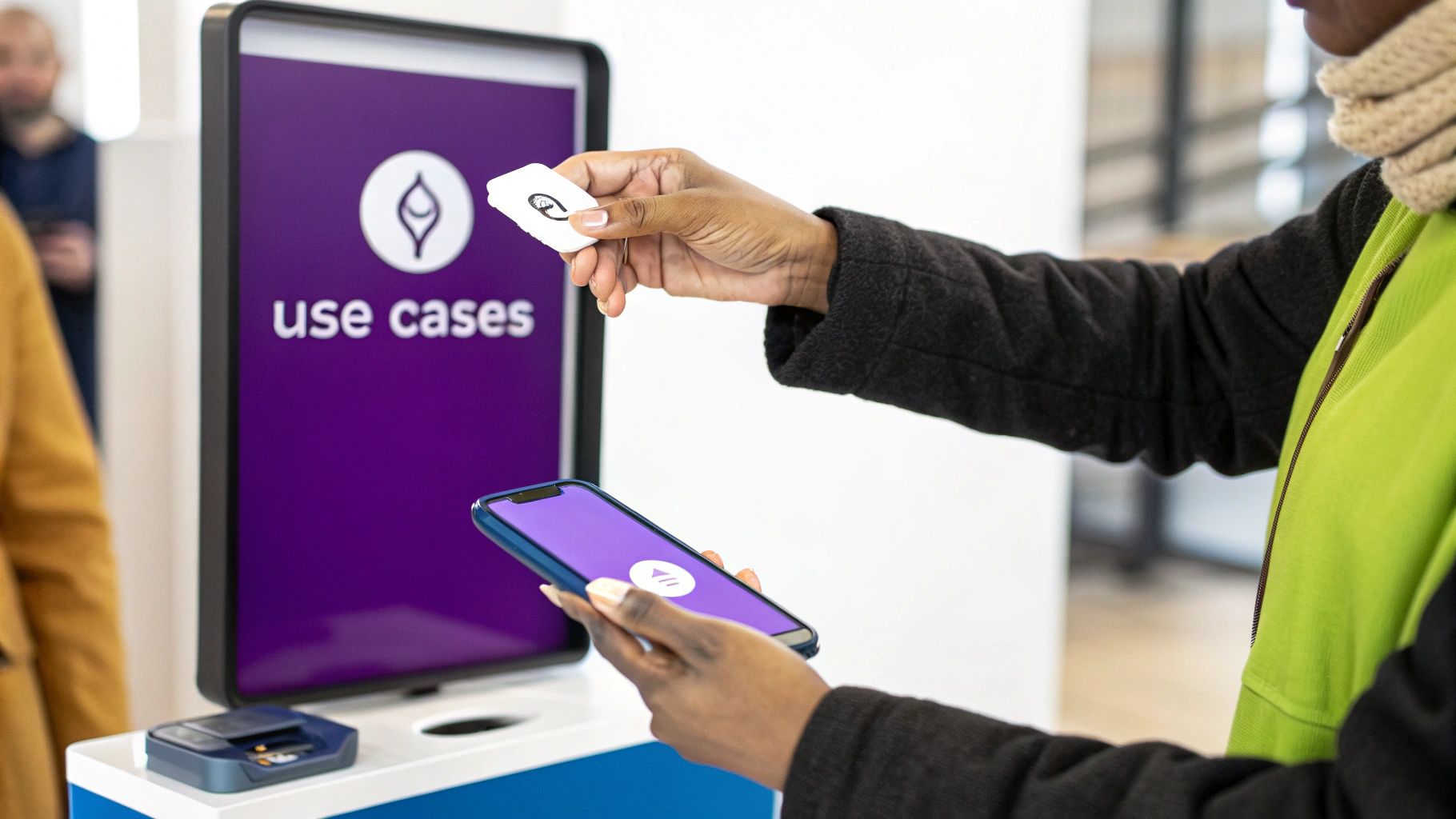
Now that we've got a handle on what a token is—a digital asset riding on another blockchain's infrastructure—it's time to dive into just how varied this world can be. Not all tokens are created equal. In fact, most are specialized tools built for very different jobs, kind of like a mechanic's toolbox has wrenches, screwdrivers, and pliers.
To really get to the bottom of "what is a token in cryptocurrency," you have to look at what it does. Most tokens fall into one of four main camps, each with its own role to play in the crypto economy.
Utility Tokens: The Keys to a Service
Utility tokens are probably the most common type you'll run into. The best way to think of them is as digital keys or access passes that unlock a specific app or service. Their value is tied directly to how popular that service is.
For example, imagine a new decentralized cloud storage platform. Instead of paying with dollars or euros, you might need the platform's own native utility token to upload files. The more people that flock to use that storage service, the more demand there is for its token. It's a simple, powerful idea.
A real-world case is the Basic Attention Token (BAT). If you use the Brave browser, you can earn BAT just for viewing ads that respect your privacy. You can then use those tokens to tip your favorite content creators. The token has a clear-cut purpose inside its own ecosystem.
Key Insight: A utility token isn't primarily an investment; it's a key that grants access. Its value is fundamentally tied to the usefulness of the project it powers.
This direct link between utility and value is what makes these tokens so fascinating. They create a new model for funding and running digital platforms, building tiny, self-contained economies around them.
Security Tokens: Digital Ownership of Real Assets
Security tokens are a huge deal because they're bridging the gap between old-school finance and the new world of blockchain. Simply put, these tokens are digital proof of ownership in a real-world, tradable asset.
This could mean a few different things:
- Company Shares: Instead of a paper certificate stashed in a filing cabinet, you hold a token that represents your equity in a business.
- Real Estate: A massive commercial building can be "tokenized," allowing smaller investors to buy a piece of a property that would otherwise be way out of their budget.
- Debt or Bonds: A loan can be turned into a token, with interest payments automatically sent out to token holders via smart contracts.
Because they represent an actual investment contract, security tokens are regulated just like stocks and bonds. They're essentially traditional financial instruments given a modern, digital upgrade, making them easier to trade and transfer.
Governance Tokens: A Voice in the Project
As decentralized projects mature, they need a way to make group decisions. Who gets to decide on a software update or a change to the fee structure? That's where governance tokens step in.
Holding a governance token gives you voting power in a project, usually a Decentralized Autonomous Organization (DAO). The more tokens you have, the more your vote counts. It's a fascinating experiment in digital democracy for online communities.
Uniswap’s UNI token is the classic example. Anyone holding UNI can vote on proposals that determine the future of the Uniswap exchange. This puts the power directly into the hands of the users, creating a network that is truly owned by its community.
Non-Fungible Tokens (NFTs): Unique Digital Certificates
Finally, we arrive at Non-Fungible Tokens, better known as NFTs. Unlike all the other tokens we've talked about, every single NFT is unique and can't be swapped one-for-one. The word "fungible" just means interchangeable—a dollar bill is fungible because any dollar can replace another. An NFT is "non-fungible," like a one-of-a-kind painting or a signed baseball card.
NFTs serve as a verifiable, on-chain certificate of ownership for an asset, which can be digital or even physical. This simple concept has blown the doors open for new markets:
- Digital Art: Artists can now sell their work directly to collectors, with ownership immutably recorded on the blockchain.
- Collectibles: Think of them as digital trading cards, rare memorabilia, or first-edition digital comics.
- In-Game Items: A rare sword or unique armor in a video game can be an NFT that a player genuinely owns and can even sell outside of the game itself.
The scale of these different token types is genuinely staggering. Stablecoins (a sub-category of tokens) accounted for about $272 billion of the crypto market cap, while NFT sales soared to nearly $1 billion in early 2023. These numbers prove just how much is happening beyond Bitcoin and Ethereum.
To dig deeper into one of the most significant categories, you can learn about the different types of stablecoins and their specific use cases). Getting a feel for these classifications is crucial for navigating platforms like vTrader, as each token type comes with its own set of risks and opportunities.
How Token Standards Like ERC-20 Work
Ever wonder how thousands of different tokens, built by teams all over the world, can play together so nicely? The magic behind this is something called a token standard. You can think of it as a universal blueprint—a shared rulebook that ensures every token built on a certain blockchain is compatible with everything else.
It’s a lot like how any USB-C cable fits into any USB-C port, no matter who made the phone or the charger. This simple agreement on design is what makes the whole system work. Without these standards, the crypto world would be a chaotic mess. Every new token would demand its own special wallet and a custom setup for every exchange, making trading an absolute nightmare.
These standards are written into smart contracts, which lay out a mandatory checklist of functions a token must have. It’s this predictability that lets your vTrader wallet seamlessly hold dozens of different tokens, all from the same blockchain network.
ERC-20: The Gold Standard for Tokens
When people talk about token standards, one name almost always comes up first: ERC-20. This is the technical standard for fungible—or interchangeable—tokens on the Ethereum blockchain. It’s the framework that underpins a huge portion of the crypto market, from stablecoins like USDT to powerhouse utility tokens like LINK.
To be ERC-20 compliant, a token's contract has to include a specific set of core functions. These rules govern everything from how tokens are transferred and how transactions get approved, to how apps can check the total supply.
To get a better idea, here’s a peek at the key functions required for ERC-20 compliance, straight from Ethereum’s own documentation.
This list of commands essentially creates a universal language. It guarantees that wallets, exchanges like vTrader, and other decentralized apps can all “talk” to any ERC-20 token without any custom translation needed.
Key Insight: ERC-20 created a common language for tokens on Ethereum. By forcing all tokens to "speak" the same way, it sparked an explosion of innovation, making it incredibly simple to launch, list, and trade new digital assets.
This standardization is precisely why you can effortlessly swap one ERC-20 token for another on a decentralized exchange or stash them all safely in a single Ethereum wallet.
ERC-721: The Blueprint for Uniqueness
So, ERC-20 is perfect for creating tokens that are all the same, like digital cash. But what about assets that are totally unique? That’s where the ERC-721 standard shines. It’s the blueprint that powers the entire world of Non-Fungible Tokens (NFTs).
Unlike ERC-20 tokens, which are identical to one another, every single ERC-721 token is one-of-a-kind and carries its own distinct ID. This makes it the perfect framework for representing ownership of unique items like:
- Digital artwork
- Rare collectibles
- A specific ticket for an event
- In-game items like a legendary sword or character skin
The ERC-721 standard includes functions specifically designed to track the ownership of each individual token. This is what allows the scarcity and history of a digital item to be proven on the blockchain, giving you undeniable proof that you own that specific, non-interchangeable asset. These two standards, working in tandem, are the true technical backbone of the modern token economy.
Real-World Applications of Crypto Tokens
Knowing what a crypto token is on paper is one thing. Seeing how they’re actually shaking up entire industries is where their real power snaps into focus. These aren't just tickers on a screen; they are functional tools building entirely new financial systems, reshaping entertainment, and even changing how we track everyday products.
These applications aren't some far-off sci-fi concept. They're happening right now. From earning interest on your assets to owning a piece of a digital world, tokens are the engine driving some of the most fascinating developments in the digital economy.
Let's dive into the most significant ways tokens are making an impact today.
Unlocking Decentralized Finance (DeFi)
Arguably the single biggest use case for tokens is in Decentralized Finance, or DeFi. The whole point of DeFi is to rebuild the traditional financial system on the blockchain, and tokens are the absolute core of it all. They are the collateral, the currency, and the reward system for a new wave of financial services.
Inside the DeFi ecosystem, tokens let you:
- Lend and Borrow: You can lend your tokens directly to others through automated protocols and earn interest, effectively becoming your own bank. You can also put your tokens up as collateral to take out a loan, all without a middleman.
- Earn Yield: This is often called "yield farming" or "liquidity mining." You supply your tokens to a decentralized exchange to provide trading liquidity and, in return, earn rewards—often paid out in that platform’s own native token.
- Trade Peer-to-Peer: Decentralized exchanges (DEXs) like Uniswap are powered by tokens, allowing users to swap assets directly from their wallets without a central company ever taking custody of their funds.
A Financial Revolution: DeFi protocols currently secure tens of billions of dollars in value. This isn't a niche experiment anymore; it's a testament to the massive demand for open and permissionless financial tools, all made possible by tokens.
Powering the Future of Gaming (GameFi)
The gaming world is also being completely rewired by tokens in a movement known as GameFi (Game Finance). For decades, when you bought an item in a game—a rare sword, a cool skin—you never really owned it. The developer did. That item was stuck inside their game, on their terms.
Tokens, especially NFTs (Non-Fungible Tokens), flip that entire model on its head.
In the GameFi model, that rare sword is a token that you genuinely own in your crypto wallet. That means you can sell it on an open market, trade it with other players, or maybe even use it in a different game that supports it. This concept of true digital ownership gives players a real, tangible stake in the virtual worlds they dedicate so much time to.
Tokenizing Real-World Assets (RWAs)
One of the most exciting frontiers for tokens is the tokenization of Real-World Assets (RWAs). This is the process of turning ownership rights of a physical or traditional financial asset into a digital token on a blockchain. The implications for unlocking liquidity and access are massive.
Think about trying to sell a tiny fraction of a commercial office building. In the old world, that’s a logistical and legal nightmare. By tokenizing the property, its ownership can be split into thousands of digital tokens, each representing a small share.
This opens up a world of possibilities:
- Fractional Ownership: Suddenly, investors can buy a small piece of high-value assets that were previously out of reach, like fine art, collector cars, or prime real estate.
- Increased Liquidity: Assets that are notoriously illiquid and might take months to sell can now be traded instantly, 24/7, on a global market.
- Enhanced Transparency: Every single transaction and change of ownership is logged on an immutable public ledger for anyone to verify.
This ability to turn almost anything of value into a tradable token is a huge leap forward, making markets far more efficient. To keep up with these fast-moving trends, you can follow the latest news and analysis in our vTrader news section.
Revolutionizing Supply Chains
Finally, tokens are being put to work to bring radical transparency to global supply chains. By creating a unique token for a product at its point of origin—say, a batch of coffee beans on a farm in Colombia—its entire journey can be tracked.
Every time that batch moves from the farmer to the shipper, to the roaster, and finally to your local cafe, the transaction is recorded on the blockchain. This creates an unchangeable, verifiable history. For consumers, it means you could scan a QR code and see exactly where your coffee came from, proving its authenticity and ethical sourcing. For businesses, it’s a powerful tool to slash fraud and boost efficiency.
How to Safely Acquire and Manage Your Tokens
So, you're ready to jump into the world of tokens. That’s great, but knowing what tokens are is only half the battle. Figuring out how to buy and manage them safely is where the rubber really meets the road. Your first move is to find a reputable and secure platform to act as your gateway.
You’ll want a well-regarded exchange like vTrader, one that takes user security and following the rules seriously. On platforms like this, you typically have two ways to get your hands on tokens. You can either buy them directly with traditional money (like U.S. dollars) or trade other cryptos you already hold—say, swapping some of your Bitcoin for a specific utility token you've been eyeing.
Choosing the Right Wallet for You
Once you own a token, you need a secure spot to keep it. This brings us to crypto wallets, which mainly come in two flavors: custodial and non-custodial.
- Custodial Wallets: These are the wallets managed by a third party, usually the exchange where you bought the tokens. They're incredibly convenient because the exchange handles all the backend security, meaning you don't have to stress about losing your private keys. The trade-off? You aren't in 100% control of your funds.
- Non-Custodial Wallets: With these, you're the one holding the private keys. This gives you complete, undisputed ownership of your assets—it's the essence of the crypto mantra, "not your keys, not your crypto." Of course, with great power comes great responsibility. If you lose those keys, your funds could be lost for good.
A common strategy is to start with a custodial wallet on an exchange for its ease of use, then transfer your assets to a non-custodial wallet for long-term safekeeping as you get more confident. It’s a smart hybrid approach that balances convenience with ultimate security.
Security First: No matter what, always enable two-factor authentication (2FA) on your exchange accounts. It’s a simple step that adds a massive layer of protection against anyone trying to gain unauthorized access, as it requires a second code from your phone to log in or make a withdrawal.
Essential Security Practices
Beyond picking the right wallet, just staying sharp is critical. The crypto world, like any financial space, has its share of scammers, so learning to spot common threats is non-negotiable. Be on high alert for phishing scams—those tricky emails or messages that look official but are really just trying to steal your login info or private keys. Never, ever click on suspicious links or share your seed phrase with anyone.
As your portfolio grows, you might also look for ways to put your assets to work. Many platforms offer features that let you earn rewards on your tokens. For a deeper dive, you can learn about crypto staking on vTrader to see exactly how that process works. By combining a secure platform, the right wallet strategy, and a healthy dose of caution, you’ll be set to manage your tokens with confidence.
Frequently Asked Questions About Crypto Tokens
As you dive deeper into the world of crypto, you're bound to run into some specific questions. Let's tackle a few of the most common ones that come up once you get past the basics.
Are All Tokens Valuable Investments?
Absolutely not. The hard truth is that for every successful token with a real-world use case, there are hundreds, if not thousands, that are tied to failed projects, pure speculation, or outright scams. A token’s value is incredibly volatile and hinges almost entirely on the credibility, utility, and community backing of the project behind it.
It's crucial to approach any token with a healthy dose of skepticism. Before you even think about buying, do your homework. Dig into the project’s whitepaper, vet the development team, and understand its tokenomics—the rules that dictate its supply and purpose. A great idea on paper doesn't always translate into a valuable asset.
Can I Create My Own Cryptocurrency Token?
Technically, yes. Thanks to established standards like ERC-20 on the Ethereum network, the process of generating a basic token has become surprisingly simple. There are even platforms that can create one for you in just a few clicks.
The Real Challenge: The easy part is minting the token. The monumental task is building a legitimate project, a dedicated community, and a genuine reason for that token to exist and hold value. The coding is just the first step; building a successful ecosystem is the real mountain to climb.
Is a Stablecoin a Type of Token?
Yes, stablecoins are a crucial category of crypto token. While most tokens are famous for their wild price swings, stablecoins are specifically engineered to maintain a steady value. They pull this off by being pegged to an external asset, most often a fiat currency like the U.S. dollar.
For instance, a token like USDC is an ERC-20 token on the Ethereum blockchain. It’s classified as a stablecoin because each USDC is designed to be redeemable for $1. Think of them as a vital bridge, connecting the stability of traditional finance with the speed and flexibility of the crypto world.
If you have more questions about tokens, wallets, or how trading works, our comprehensive vTrader FAQ page has plenty more answers to help guide you.
Ready to explore the world of tokens with confidence? vTrader offers a secure, zero-fee platform to buy, sell, and manage a wide range of digital assets. Get started today and trade smarter at https://www.vtrader.io.

Steve Gregory is a lawyer in the United States who specializes in licensing for cryptocurrency companies and products. Steve began his career as an attorney in 2015 but made the switch to working in cryptocurrency full time shortly after joining the original team at Gemini Trust Company, an early cryptocurrency exchange based in New York City. Steve then joined CEX.io and was able to launch their regulated US-based cryptocurrency. Steve then went on to become the CEO at currency.com when he ran for four years and was able to lead currency.com to being fully acquired in 2025.
